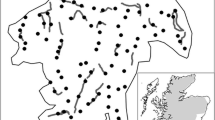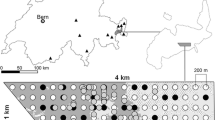Abstract
Non-invasive genetic sampling using materials such as faeces or hair can be used to monitor wildlife populations, although DNA quality is often poor. Improving sampling efficiency and minimising factors that reduce DNA quality are therefore critical. After a severe decline, the European pine marten, Martes martes, has reclaimed much of its former range in Scotland, UK. Recording this rapid range expansion requires developing techniques for accurate monitoring, but this is hampered by the species’ elusive behaviour. We tested two sampling methods, hair collected from hair tubes and faeces (scat) collected along tracks, to assess the effects of key environmental and sampling variables on DNA quality and sampling efficiency. For hair, we tested the influence of hair tube location (distance from forest tracks) on collection rate and sex ratio of animals successfully sampled. For scats, we assessed the effect of time since defecation (1 to 16 days) on genotyping error rates and success under two contrasting environmental conditions (exposed to rainfall or sheltered). We found no bias in the collection rate or sex ratio of animals detected by hair samples with differing proximity to forest tracks. DNA amplification failure for scats exposed to rainfall increased from 28 to 65 % over the 16-day experimental period. During periods of low rainfall, the length of collection sessions could therefore be extended to increase sample number without risk of DNA degradation. Lack of bias in hair collection rates with proximity to forest tracks provides justification for tube placement close to tracks, as this reduces survey effort. These findings provide guidance for the development of efficient and cost-effective non-invasive sampling of Scottish pine martens.





Similar content being viewed by others
References
Boulanger J, Proctor M, Himmer S, Stenhouse G, Paetkau D, Cranston J (2006) An empirical test of DNA mark-recapture sampling strategies for grizzly bears. Ursus 17:149–158
Brinkman TJ, Schwartz MK, Person DK, Pilgrim KL, Hundertmark KJ (2010) Effects of time and rainfall on PCR success using DNA extracted from deer fecal pellets. Conserv Genet 11:1547–1552
Broquet T, Menard N, Petit E (2007) Noninvasive population genetics: a review of sample source, diet, fragment length and microsatellite motif effects on amplification success and genotyping error rates. Conserv Genet 8:249–260
Broquet T, Petit E (2004) Quantifying genotyping errors in noninvasive population genetics. Mol Ecol 13:3601–3608
Brøseth H, Flagstad Ø, Wärdig C, Johansson M, Ellegren H (2010) Large-scale noninvasive genetic monitoring of wolverines using scats reveals density dependent adult survival. Biol Conserv 143:113–120
Burki S, Roth T, Robin K, Weber D (2009) Lure sticks as a method to detect pine martens Martes martes. Acta Theriol 55:223–230
Caryl FM, Raynor R, Quine CP, Park KJ (2012a) The seasonal diet of British pine marten determined from genetically identified scats. J Zool 288:252–259
Caryl FM, Quine CP, Park KJ (2012b) Martens in the matrix: the importance of nonforested habitats for forest carnivores in fragmented landscapes. J Mammal 93:464–474
Chandrasekhar A (2005) The evaluation of bait-marking as a method for delineating pine marten (Martes martes) territories in South-east Ireland, Dissertation, University of Kent
Cossios ED, Madrid A, Condori JL, Fajard U (2007) Update on the distribution of the Andean cat Oreaflurus jacobita and the pampas cat Lynchailurus colocolo in Peru. Endanger Species Res 3:313–320
Croose E, Birks JDS, Schofield HW (2013) Expansion zone survey of pine marten (Martes martes) distribution in Scotland. In: Scottish Natural Heritage Commissioned Report No. 520
Davies GM, Legg CJ (2008) The effect of traditional management burning on lichen diversity. Appl Veg Sci 11:529–538
Fabbri E, Caniglia R, Mucci N, Thomsen HP, Krag K, Pertoldi C, Loeschcke V, Randi E (2012) Comparison of single nucleotide polymorphisms and microsatellites in non-invasive genetic monitoring of a wolf population. Arch Biol Sci 64:321–335
Faraway JJ (2005) Extending the Linear Model with R. Chapman & Hall, Boca Raton, FL
Frantz AC, Pope LC, Carpenter PJ, Roper TJ, Wilson GJ, Delahay RJ et al (2003) Reliable microsatellite genotyping of the Eurasian badger (Meles meles) using faecal DNA. Mol Ecol 12:1649–1661
Gelman A, Hill J (2007) Data analysis using regression and multilevel/hierarchical models. Cambridge University Press, New York
Gibbs JP, Snell HL, Causton CE (1999) Effective monitoring for adaptive wildlife management: lessons from the Galapagos Islands. J Wildl Manag 63:1055–1065
Head JS, Boesch C, Robbins MM, Rabanal LI, Makaga L, Kuhl HS (2013) Effective sociodemographic population assessment of elusive species in ecology and conservation management. Ecol Evol 3:2903–2916
Kohn MH, York EC, Kamradt DA, Haught G, Sauvajot RM, Wayne RK (1999) Estimating population size by genotyping faeces. Proc Royal Soc B Biol Sci 266:657–663
Lockie JD (1964) Distribution and fluctuations of the pine marten, Martes martes (L.), in Scotland. J Animal Ecol 33:8
Lucchini V, Fabbri E, Marucco F, Ricci S, Boitani l, Randi E (2002) Noninvasive molecular tracking of colonizing wolf (Canis lupus) packs in the western Italian Alps. Mol Ecol 11
Lynch ÁB, Brown MJF, Rochford JM (2006) Fur snagging as a method of evaluating the presence and abundance of a small carnivore, the pine marten (Martes martes). J Zool 270:330–339
Mullins J, Statham MJ, Roche T, Turner PD, O’Reilly C (2009) Remotely plucked hair genotyping: a reliable and non-invasive method for censusing pine marten (Martes martes, L. 1758) populations. Eur J Wildl Res 56:443–453
Murphy MA, Kendall KC, Robinson A, Waits LP (2007) The impact of time and field conditions on brown bear (Ursus arctos) faecal DNA amplification. Conserv Genet 8:1219–1224
Natali C, Banchi E, Ciofi C, Manzo E, Bartolommei P, Cozzolino R (2010) Characterization of 13 polymorphic microsatellite loci in the European pine marten Martes martes. Conserv Genet Resour 2:397–399
Nsubuga AM, Robbins MM, Roeder AD, Morin PA, Boesch C, Vigilant L (2004) Factors affecting the amount of genomic DNA extracted from ape faeces and the identification of an improved sample storage method. Mol Ecol 13:2089–2094
O’Mahony D, Turner P, O’Reilly C (2012) Population status of pine marten in an isolated refuge: the Mourne Mountains. In: A report to the Peoples Trust for Endangered Species and Northern Ireland Environment Agency
Panasci M, Ballard WB, Breck S, Rodriguez D, Densmore LD, Wester DB et al (2011) Evaluation of fecal DNA preservation techniques and effects of sample age and diet on genotyping success. J Wildl Manag 75:1616–1624
Piggott MP, Taylor AC (2003) Extensive evaluation of faecal preservation and DNA extraction methods in Australian native and introduced species. Aust J Zool 51:15
Roche T (2008) The use of baited hair traps and genetic analysis to determine the presence of Pine marten, Dissertation, Waterford Institute of technology
Scheppers TLJ, Frantz AC, Schaul M, Engel E, Breyne P, Schley L, Roper TJ (2007). Estimating social group size of Eurasian badgers Meles meles by genotyping remotely plucked single hairs. Wildl Biol 13:195–207
Sheehy E, Lawton C (2014) Population crash in an invasive species following the recovery of a native predator: the case of the American grey squirrel and the European pine marten in Ireland. Biodivers Conserv 23:753–774
Summers RW, Willi J, Selvidge J (2009) Capercaillie Tetrao urogallus Nest Loss and Attendance at Abernethy Forest, Scotland. Wildl Biol 15:319–327
Summers R, Dugan D, Proctor R (2010) Numbers and breeding success of capercaillies Tetrao urogallus and black grouse T. tetrix at Abernethy Forest, Scotland. Bird Stud 57:437–446
Taberlet P, Luikart G (1999) Non-invasive genetic sampling and individual identification. Mol Genet Anim Ecol 41-55
Taberlet P, Griffin S, Goossens B, Questiau S, Manceau V, Escaravage N et al (1996) Reliable genotyping of samples with very low DNA quantities using PCR. Nucleic Acids Res 24
Twiddle CL, Quine CP (2011) Revealing the vegetation history of Inshriach Forest: application of new quantitative reconstruction techniques to pollen records covering 3000 years. Scott For 65:19–27
Uno R, Kondo M, Yuasa T, Yamauchi K, Tsuruga H, Tamate HB, Yoneda M (2012) Assessment of genotyping accuracy in a non-invasive DNA-based population survey of Asiatic black bears (Ursus thibetanus): lessons from a large-scale pilot study in Iwate prefecture, northern Japan. Popul Ecol 54:509–519
Walsh PS, Metzger DA, Higuchi R (1991) Chelex-100 as a medium for simple extraction of DNA for PCR-based typing from forensic material. Biotechniques 10:506–513
Weckel M, Giuliano W, Silver S (2006) Jaguar (Panthera onca) feeding ecology: distribution of predator and prey through time and space. J Zool 270:25–30
Whittingham MJ, Stephens PA, Bradbury RB, Freckleton RP (2006) Why do we still use stepwise modelling in ecology and behaviour? J Anim Ecol 75:1182–1189
Wilson DJ, Efford MG, Brown SJ, Williamson JF, McElrea GJ (2007) Estimating density of ship rats in New Zealand forests by capture-mark-recapture trapping. N Z J Ecol 31:47–59
Zuur A, Leno EN, Walker N, Saveliev AA, Smith GM (2009) Mixed effects models and extensions in ecology with R. Springer, New York
Acknowledgments
We would like to thank David Bavin, Lizzie Croose, Tara Curry, Melissa Simmons and Kayleigh McCrory for help with data collection; Stuart A’Hara, Bridget Laue (Forest Research) and Catherine O’Reilly (Waterford Institute of Technology, Ireland) for advice on genetic analysis; and Ron Summers (RSPB) for advice and support. This project was funded by the University of Stirling, Forestry Commission, Forest Research, the Royal Society of the Protection of Birds and Scottish Natural Heritage.
Author information
Authors and Affiliations
Corresponding author
Additional information
Communicated by: Andrzej Zalewski
Rights and permissions
About this article
Cite this article
Kubasiewicz, L.M., Minderman, J., Woodall, L.C. et al. Fur and faeces: an experimental assessment of non-invasive DNA sampling for the European pine marten. Mamm Res 61, 299–307 (2016). https://doi.org/10.1007/s13364-016-0276-y
Received:
Accepted:
Published:
Issue Date:
DOI: https://doi.org/10.1007/s13364-016-0276-y




